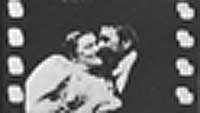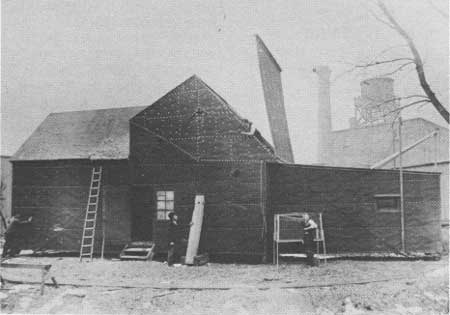|
Beehives of Invention Edison and His Laboratories |
 |
Crucibles of Creativity: The Labs (continued)
While the ore-processing fiasco had taken up the better part of Edison's creative time for a decade, all was not lost. Some of the diversions he engaged in during this time were remarkably successful. One was motion pictures.
 In a caveat filed with the Patent Office (top), Edison discloses that he is "experimenting upon an instrument which does for the Eye what the phonograph does for the Ear," and shows how this motion picture equipment would work (bottom). |
As early as 1887, Edison had revealed his idea for a camera that would record motion to William K. L. Dickson, a young English immigrant employed at the lab. Dickson was a camera enthusiast who worked closely with Edison during a decade of experimentation and development of what was to become the first successful motion picture camera. Most historians believe the celluloid film Strip Kinetograph camera was first successful in 1889. Edison and Dickson also created the peephole Kinetoscope, which presented the first paid public motion picture shows in 1894.
 Edison's 1889 Strip Kinetograph was the first workable motion picture camera in America to use strip film. The film ran horizontally. |
From The Man Who Brought You The Movies More Information |
The work on the motion picture idea went on despite the little time the ore-preoccupied Edison personally devoted to the project. Great credit is due his able assistants, especially Dickson, in this venture, much more perhaps than in any other Edison project which required much developmental work. In 1893, the Black Maria was built as the first specially designed motion picture studio. Here and in the nearby countryside the very earliest motion pictures were made.
Edison, against Dickson's advice, did not actively try to create a projector-screen combination. Edison thought the use of a screen for a mass audience would diminish the market for projectors too much. While Louis Lumière, Thomas Armat, and others went on to devise systems using a screen on a wall, Edison stuck with his peep-show Kinetoscope. He foolishly lost Dickson to a competitor during this period which became rank with litigations and patent infringements. But the Edison patents were to help keep him rich for many years. All inventors and improvers of motion picture cameras and projectors of the day owed much to his Kinetograph, Kinetoscope, and other early experiments.
 "With its flapping sail-like roof and ebon hue," the Dicksons wrote, the Black Maria "has a weird and semi-nautical appearance, and the uncanny effect is not lessened when, on an imperceptible signal, the great building swings slowly around upon a graphited centre, presenting any given angle to the rays of the sun, and rendering the operations independent of diurnal variations." |

|

|
|
|
|
Last Modified: Thurs., May 19 2005 10:00:00 am PDT |


